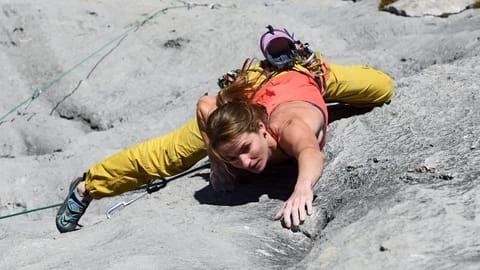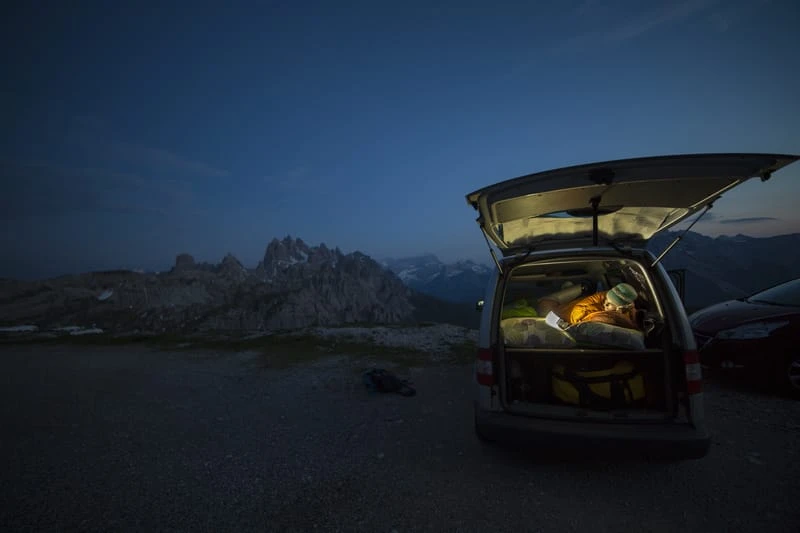Sport - Interview

Interview with Barbara Zangerl, Professional Rock Climber
Sport - Interview
by Meryem Aksoy
When you wake up one morning, you may decide to ride, run, or swim, even if you've never done it before. However, climbing is not a sport that can be started in this way. Without the passion for climbing that comes from their depth, no one can reach the summit by clinging to tiny crevices and cracks. Climbing requires the highest level of fitness, concentration, goal orientation, and passion. Climbing is a lifestyle more than a sport. Barbara Zangerl is a rock climber who successfully manages a balance between work, social life, and climbing career. Barbara suffered a serious injury in 2009, but she did not give up and even returned to a more powerful way and specialized in new climbing styles. Babsi, as everyone called her, has climbed many of the world's toughest walls, including the most challenging routes in Eiger and El Capitan. I had the chance to interview Barbara Zangerl, and I talked with her about the highlights of her 15-years of career, and I asked questions to learn her opinions about the importance of individual sponsorship in rock climbing.
Barbara, you have been climbing since you were 14 years old. How did you discover the climbing passion that takes you to the rocks? Who or what encouraged you?
I began climbing at the age of 14 when my brother brought me to the local climbing gym. I enjoyed climbing from the very first minute and quickly became obsessed with the sport.
Later on, I met Bernd Zangerl-(no relation). He was already a professional rock climber at this time and took my sister Claudia and me from the gym to rock climbing. Together we checked out the various boulder regions in Austria and Switzerland. I can very well remember my first rock face experience. Back then I could hardly imagine that climbing on a natural surface could be so much better than what I did before. It was an incisive experience for me and whenever possible next to a commercial school, I spent time climbing outside. All my free time I spent on bouldering for six years and travelled to the different bouldering areas around the world.

Barbara Zangerl - Photo by Robert Bösch (Unendliche Geschichte, Ratikon, CH)
Could you tell us about yourself? Who is Barbara Zangerl?
Hmmmm hard question. I am just a normal person who really loves climbing and traveling.
Sometimes I can get quite stubborn about different things in life especially having climbing projects. It’s quite hard for me to give up.
I love the process of projecting a big wall and the simple life on the wall. But I also love climbing easy routes or just go skiing in winter. I would call myself an all-round climber—I love all styles and the variety of climbing.
But I also have a part-time job in the hospital as a radiographer. I need this kind of balance in life...
Who gave you the name Babsi? How does it feel to have a nickname?
Most of the people call me Babsi. They already did when I was a child… I have some other nicknames—so this one is definitely the best of those :-)
How did your injury in 2009 change your climbing career?
It changed my life. At this time I was just a boulder fanatic who spent all the free time on bouldering.
After the injury, I had to stop bouldering for a very long time. That opened my eyes. I had to change and accept that I can’t keep on doing what I loved so much at this time. The rehab was quite long and hard, but I learned a lot about taking more care of my body/listen to my body. One of my rehab exercises was rope climbing. This actually was the reason why I started rope climbing. First I got more and more into Sport climbing… and after a while, I found out that climbing has much more to offer.
I searched for bigger adventures and got finally into Bigwall climbing and started to love to do all different styles of climbing. That was the key to stay motivated for climbing all over the year. There was always something new to learn, where I had to start at a very low level—for example, crack climbing. Or the mental challenge in trad or big wall climbing… that was very exciting from the beginning on!

Barbara Zangerl - Photo by Francois Lebeau
You have climbed to the most famous routes on Eiger and El Capitan, such as Magic Mushroom and Odyssee. Could you tell us about your climbing career and achievements?
When I first stood in front of El Capitan, I couldn’t imagine that I will be able to free climb this gigantic granite wall.
I had this feeling quite often in my climbing career. At first most of those big projects looked impossible to me.
However, after I started to try them, I got more and more used to the style and to the exposure. After the first impressions (after some days) I often came to the point that I could imagine that there is a chance to climb those routes.
The process to project routes like those is very interesting to me. It is a big journey. Every route or wall is different. There is always a big question mark in front of it. Is it too hard? Is there a single move for what I am simply not strong enough, or are the weather conditions all right? You never know! That’s exciting…
All those routes are great memories which remind me of very good times with people I love to climb and hang out with.
What was your biggest achievement?
Not sure! "Magic Mushroom" on El Capitan felt very hard to me, maybe the hardest big wall I have climbed…"Bellavista" at the Tre Cime, Dolomites - felt super scary to me.
"Delicatessen" in Corsica was one of the most beautiful lines I have ever climbed.
Climbing the alpine Trilogy! I am the most proud of. And speed integrale was my greatest sport climbing achievement.
What are your favorite and dream routes?
Hotel Supramonte (Sardinia, ITA)
Delicatessen (Corsica, FR)
Silbergeier (Rätikon, CH)
Unendliche Geschichte (Rätikon, CH)
via acacia (Rätikon, CH)
Moonlight buttres (Zion, Utah)
The whole EL CAP, Yosemite
Super Cirill (Ticino, CH)
Sport climbing in Voralpsee (CH), Zillertal (AUT)
can’t stop—-sorry!
What does climbing means for you?
It means a lot to me!

Barbara Zangerl - Photo by Thomas Senf (Bellavista, Tre cime, Dolomites)
We are facing financial problems at every moment of our lives. What are the primary financial problems that climbers have been living during their climbing career?
Climbing is a fringe sport. Compared to some other popular sports it is harder to make a living out of climbing.
Most of the climbers love a simple lifestyle. Camping outdoors/ van life. So you can save some money living simply. However, all the traveling is quite expensive.
In the past, I worked more in the hospital, and today I can make a living out of climbing thanks to my Sponsors… I am very very thankful for all that!
How could climbers solve these problems? What is the permanent solution?
Solution: the perfect balance between work and climbing trips.
What is the best way to attract sponsors' attention?
Good ideas about interesting projects. Great achievements, Video or pictures about that and promotion on all possible media channels.
In your career, when did you first attract sponsors' attention? How did you do this?
My first sponsor was Black Diamond…at the age of 15 they asked me if I need climbing gear, crashpads for my bouldering trips. Black Diamond is still my main partner. They have been supporting me over more than 15 years.

Barbara Zangerl - Photo by Thomas Senf (Bellavista, Tre Cime, Dolomites)
What contributions do sponsor brands provide climbers?
They mostly provide climbers gear and/or financial support for the year or for some specific projects. They help the sponsored climbers to produce content, and they increase their visibility through their channels.
What do sponsors expect and demand from climbers?
They should represent the image of the brand in the best way, inspire people with their content and achievements, be active on social media, take part in events, help developing new products with feedbacks and ideas...
Could you tell us about your sponsors and partners? What are the brands that you collaborate with?
Black Diamond-main partner (15 years) (hardware and apparel)
La Sportiva (5 years) (climbing and approach shoes)
Vibram (shoe rubber)
Verival bio (natural organic food)
Power Bar (climbing power bars)
Friction Labs (climbing chalk)
Faza Brushes (handmade brushes)
Climbskin (skin care)
How many different platforms do you represent your sponsors throughout the year?
Besides my climbing, I represent my sponsors through slideshows, social media, web, and printed media, events and trade shows and TV channels.

Barbara Zangerl - Photo by Jacopo Larcher
What are your expectations from your sponsors and partners?
Work professionally and maintain the right balance between events and personal projects.
What are you paying attention to when a new brand contacted you about sponsorship? What features should the brand have?
Brand philosophy, products, marketing, and how they want to work together? I want to stay authentic as a person and climber. Realize my own ideas and goals!
What are the main factors that affect the beginning and continuity of successful sponsorship?
Trust, motivation, balance, professionalism, support, honesty, clarity.
If you had a chance to speak on behalf of all professional climbers at a meeting with brands, what would you say them for convincing these brands to sponsor professional climbers?
When I started climbing, I had my personal heroes in climbing. People who inspired me and still inspiring me!!
So I think it’s important to all the brands to have professionals in their sports who inspire people in different ways.

Barbara Zangerl - Photo by Francois Lebeau (Magic Mushroom)
Do you have any advice for climbers who want to pursue a professional career?
Be focused on what you want to do!!! Always remind yourself why you climb! And don’t let take over the business. Find the right balance, be honest to your self and follow your passion.
What do you think about social media? How did it affect the popularity of rock climbing?
I don’t think that climbing got more popular because of Social media. It’s just easier now to follow everything what is going on in the climbing world.
The climbing got more popular because it is easier to get into climbing at this time. More gyms, workshops, bouldering, the creativity, working together on a route all this makes it very interesting to people. The social aspect of climbing compared to a regular gym work out is one point why people get motivated to try out climbing.
Social media have definitely changed the marketing strategies of the brands and the work of the athletes. They are very efficient platforms for sharing content and reach out to the people, both for the athletes and for the brands. The negative side is probably the fact we always feel the need of posting something.
People are way too much on their phones… also, I am! I don’t think it will go on like that! I don’t think that’s the future.
How can our readers follow you?
On Instagram: https://www.instagram.com/babsizangerl/
Facebook: https://www.facebook.com/barbara.zangerl/
What is next for you?
In June we will go back to Yosemite Valley—to try the Nose!
Thank you Barbara for your time.
For more information, please click here to visit the website of Barbara Zangerl
This interview was conducted in a Question-and-Answer format. The answers were checked for grammar and punctuation and published without any additional editing. Monday, April 22, 2019. All photos are the property of their respective owners.